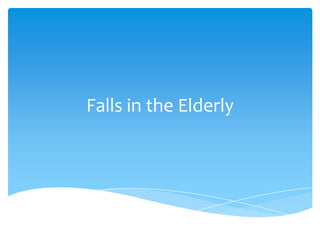
Ec falls in the elderly
- 1. Falls in the Elderly
- 2. Learning Objectives Identify scope of the problem Describe contributing factors for falls
- 3. How serious is the problem of falls?
- 4. Incidence rates of Falls in U.S. One of every three adults over 65 years fall in every year One of every two adults over age 80 fall annually
- 5. Where are people likely to fall? For people 65 years old or older….. Nursing Home 10% Public Places 30% Home 60%
- 6. How big is the problem? • Falls are the leading cause of injury among people over 65 years • Of those who fall, 20-30% suffer severe injuries that make it hard for them to get around or live independently Older adults are hospitalized for fall related injuries 5 times more often then they are for injuries from other causes
- 7. Consequences of Falls Mortality Morbidity Fractures Soft tissue injuries Head trauma/TBI Joint distortions and dislocations Loss of confidence - fear of falling Restricted activity
- 8. Costs In 2000, estimated fall-related injury cost was $19.2 billion Medicare costs per fall averages between $9,000 and $13, 500 Cost of fall injuries increase with age Cost of fall injuries are higher for women than men
- 9. Unintentional Fall Death Rates by Gender, Age 65 +, U.S. 1996 140 120 100 Men Per 100,000 80 Women 60 40 20 0 65-74 75-84 85+ Source: National Center for Health Statistics, Vital Statistics
- 10. Unintentional Fall Age-Adjusted Death Rates, Age 65 +, gender and race U.S. 35 White, Men 30 25 20 White, Women 15 Black, Men 10 5 Black, Women 0 1981 1982 1983 1984 1985 1986 1987 1988 1989 1990 1991 1992 1993 1994 1995 1996 1997 1998 Source: National Center for Health Statistics, Vital Statistics
- 11. Fractures 3% of all falls cause fractures. Approx. 95% of hip fractures in older people aged over 65 years are the result of a fall People who have a hip facture are 5 ~20% more likely to die in the first year following the injury than any other reason in the same age groups
- 12. Fear of Falling Loss of self confidence Decrease of physical activity level and quality of life Fear of not being able to get up after a fall
- 13. Risk Factors Intrinsic (Personal) risk factors for Falls Aged (over 65 years) Female Poor mobility or fragility – lower extremity weakness, and poor grip strength Functional impairments - limited Activities of Daily living (ADL) Poor gait and balance Low body weight
- 14. Intrinsic (Personal) risk factors for Falls continued… Cognitive impairment or dementia Chronic illness - Parkinson disease, visual difficulties, stroke, hypertension, or urinary incontinence Psychoactive medications - tranquilizers or antidepressants Previous falls Heavy drinking
- 15. Relative risk ratio (RR) or Odd Ratio (OR) of Fall 5,0 4,4 4,5 Mean RR or OR 4,0 3,5 2,9 2,9 3,0 3,0 2,4 2,5 2,6 2,3 2,2 2,5 1,8 2,0 1,7 1,5 1,0 0,5 0,0 rs ss icit icit DL ent ion itis icit lls ice y ea ne ef ef A m ss hr ef f fa ev 8 0 eak it d e d red air re Art al d y o e d i p > w Ga anc pa imp De u r iv is sto ist e ge scl al Im ve V i s H as A u B iti M ogn se C U J Am Geriatr Soc. 2001
- 16. Extrinsic or Environmental Factors Polypharmacy – four or more prescription medications combination Home hazards Clutter, or loose rugs Poor lighting on stairs and hallways Lack of bathroom safety, e.g. grab bars in bathtub Footwear Busy street or elevated walkways
- 17. Personal Prevention Exercise/physical activity especially geared to gait and balance and flexibility Medicines reviewed Vision checked Improving home safety
- 18. Assistant Devices Hip pads Mobility aids Cane Walkers Wheelchairs Bathroom aids - Raised toilet seats - Grab bars
- 19. Resources CDC’s National Center for Injury Prevention and Control National Resource Center on Aging and Injury WHO –Ageing and Life Course National Fire Protection Association National Women’s Health Information Center Elder Web Additional Reading List